The Amazon River channel varies in average depth between about 15 and 40 meters. The presence of islands and heavy sedimentation on the floodplains greatly reduces channel width to an average of about 2 to 3 km. The Amazon is usually split into several channels because of the presence of islands. High natural levees border the main river and they are inundated only at the peak of the floods. Large floodplain areas in back of the first levees, however, remain connected to the main river by one or more channels that cut through the levees.
Major fisheries in Amazon River channels depend on migratory species, which may be divided into two main groups. Long-distance migratory species of major commercial value are all catfishes in the family Pimelodidae. Some species of the family Doradidae also appear to make long-distance migrations. These species migrate from the Amazon estuary to the Andean foothills or to headwaters in the Purus River, Juruá River, and perhaps Branco River of the Negro Basin. The longest of these migrations is at least 5,000 km in one direction. The long-distance migratory species are most abundant in the whitewater rivers. The second type of river channel migration consists of species that migrate 100 to 500 km annually; these migrations may involve the main stem and several tributaries.
With the exception of the estuary, fisheries for river channel catfish were minimal before about the 1970s because of taboos against eating catfish. Immigration from outside the region and urbanization have largely broken down these taboos. Once refrigeration plants were available in the 1970s, river channel catfish began to be heavily exploited. Porto Velho in Brazil and Leticia in Colombia were the first cities to buy large quantities of Amazon catfish from inland waters. By the 1970s, Porto Velho had road connections with southern Brazil that allowed frozen catfish to be exported. Catches from the Leticia area were sent by plane to Bogotá. Today migratory catfish species are exploited by the fleets of Belém, Santarém, Manaus and Tefé in Brazil; Leticia in Colombia; and Iquitos, Yurimaguas and Pucallpa in Peru. Dourada and piramutaba are the two most important species captured in river channel fisheries.
River channel catfish migrations are detected by experienced fishermen who can interpret the subtle ripples generated by piramutaba or dourada when these fishes gently break the surface. Gill nets are the main gear used to capture migrating dourada and piramutaba, whereas trotlines are commonly employed to take a variety of other species, such as piraíba and jaú. The gill nets used to catch catfish in river channels are drifting gill nets. The mesh section of the net is sunk to desired depths by adding or removing lead weights and then maintained at those depths by ropes attached to large floats. A drifting gill net might be floated downstream for a few hours, covering a distance of perhaps 10 km, though shorter times and distances are more common. The time and distance depend on the density of obstacles on the bottom, such as sunken trees, that may entangle the net. The nets need to be retrieved on a regular basis because dolphins and small voracious catfish called candiru of the families Cetopsidae and Trichomycteridae attack fish entangled in the nets. These predators can destroy an entangled fish in a few minutes.
Seines can also be used in some river channel situations to capture migratory catfish, such as near beaches. This method is commonly used by Manaus fishermen. The catfish seine differs from counterparts used to catch smaller fish in the Amazon in that it has larger mesh size, heavier line and a height of 45 meters or more. Seines used to catch smaller fish usually measure no more than about 25 meters in height. When piramutaba are migrating upstream, seine fishermen locate submerged beaches over which the schools will pass. The 300 to 500 meter seines are stretched as perpendicular as possible. When the school arrives in the beach area the net is closed and dragged ashore. This method may capture up to 30 tons in one seining, which is often enough to fill a boat to its capacity.
Hooks are used on trotlines or hand-lines. Trotlines consist of a 100 to 300 meter line, which are connected 2 to 5 meter lines with hooks. Hand-lines usually have only one hook and require that the fisherman be present, whereas trotlines can be left alone and periodically checked for catches. The baits used change according to region. Large gobies are commonly used in the estuary, whereas in the Central Amazon various characin fishes, such as matrinchã (Brycon) and jaraqui (Semaprochilodus), both also commercial food fishes, are said to be the best bait. Trotlines used in river channels are tied either to a tree, shrub or stake along the shore or to a floating object, such as wood, Styrofoam or plastic containers. Both options necessitate the use of a weight to anchor the end of the line holding the hooks to the bottom. Usually four to seven hooks are used when the trotline is sunken in the middle of the channel. When it is stretched near to shore, many more hooks are often used. The hooks are suspended on short lines 0.5 to 3 meters in length. Hooks are usually baited just before sunset and checked at daybreak. After a catfish is hooked it remains relatively calm until the fishermen begin to pull it in.
Fishermen know that when the fish arrives near the surface it will turn and run and they are ready for this dangerous moment. Because other hooks may have been pulled aboard ahead of the one that the catch has bitten into, great care must be taken that the catfish does not pull these through the hands of the fishermen. If a fisherman gets accidentally hooked, a large catfish, or a catch of two or three large catfish, could pull him overboard for a submerged ending to his life.
Large catfish, along with the boto and tucuxi dolphins, are the main fish predators in Amazon River channels. There are at least 14 large (>50 cm) catfish species in the Amazon Basin that can be considered predators and most of them are migratory. Most of these species belong to the genera Brachyplatystoma and Pseudoplatystoma.
Brachyplatystoma species are captured in the main rivers of the Amazon Basin from the estuary to the Andean foothills and also in the large clearwater rivers draining the Brazilian and Guiana shields. The largest species is the piraíba (B. filamentosum), though a recently described species (B. capapretum) could potentially get as large as the piraíba. Dourada (B. rousseauxii) and piramutaba (B. vaillantii) are the most important commercial catfish species in river channel fisheries. Dourada catches are more scattered than those of piramutaba, the latter concentrated mostly from the Central Amazon to the estuary. The distribution of babão (B. platynemum) in whitewater rivers and the estuary mirrors that of the dourada and, like the latter, it is heavily exploited over a wide area of the Amazon Basin. Other species of Brachyplatystoma captured in river channels include the flamengo (B. juruense) and dourada zebra (B. merodontotus).
There are at two species of the genus Pseudoplatystoma commonly captured in river channels, but these fishes are also commonly exploited in floodplain lakes. The surubim (P. fasciatum) and caparari (P. tigrinum) are usually captured near margins, such as in beach waters at night. The two species are usually lumped together as surubim in Amazon fisheries statistics.
The pirarara (Phractocephalus hemioliopterus) is a large omnivore that feeds heavily on fruits in flooded forests during the floods. It can be common in river channels during the low water period. The jaú (Zungaro zungaro) is commonly captured with trotlines in deep channels or at cataracts with large cast nets. Coroatá (Platynematichthys notatus), peixe-lenha (Sorubimichthys planiceps) and piracatinga (Calophysus macropterus) are occasionally encountered in large upstream-migrating schools, but little is known about their migratory biology.
Our knowledge of river channel catfish migrations is based on statistical data from fisheries and experimental fishing of three species that migrate between the estuary and the western Amazon or Andean foothills. Dourada migrates to the Andean foothills or nearby to spawn and their young migrate downstream to the estuary, which is their nursery. The babão has a similar pattern though its nursery has yet to be located, though probably includes at least in part the estuary. Adult fish of these species do not return to the estuary. In contrast, piramutaba also migrate upstream to spawn in the western Amazon but adults and larvae migrate downstream to the estuary. The exact spawning areas of piramutaba in the western Amazon are still not known though they are now known to reach the Andes.
Dourada and babão begin to migrate out of the estuary at two years of age and they appear to take two years to reach the Andes before spawning. They use Central Amazon River channels as feeding areas, where they attack other migratory fish, such as characins and a variety of nonmigratory species. Upriver migrations out of the estuary begin in May or June when salt water begins to move into Marajó Bay and along the eastern coast of Marajó. This period also coincides with the period when many fish species are moving off the floodplains and into the river channels. The predatory catfish are ecologically tuned to the displacement of floodplain fish populations to the river channels. Large schools of piramutaba are captured near Santarém, 880 km upstream, in August and September. Near Manaus in the Central Amazon, 1,700 km upstream, schools are captured in September and by October peak catches are made near Leticia, 3,300 km upstream. In contrast to piramutaba, dourada is most heavily exploited upriver of the estuary. It is an important commercial species from the estuary to the Andean foothills. Large schools of dourada are encountered in the lower Amazon River between August and October. Dourada catches at Leticia, Colombia are relatively high during the entire year because of the presence of large populations of adult fish. Babão appears to be relatively rare compared to dourada and piramutaba, though it also makes long-distance migrations that originate in the estuary. Babão is captured mostly when migrating upstream at the same time as the dourada.
The confluence of the Madeira and Amazon rivers marks an important splitting point of upstream migrating catfish schools. The factors that influence whether schools continue upstream in the Amazon River or enter the Madeira River are unknown. Fisheries statistics clearly show that dourada schools migrate upstream in both rivers during most if not all years. Return to rivers of birth, or homing, could be a possibility. In contrast, fisheries statistics indicate that piramutaba schools usually continue up the Amazon River. Interestingly, however, during years when river levels of the Madeira River are very low and water transparency increases, large schools of piramutaba migrate as far upstream as the Madeira Rapids just above Porto Velho, though this area has now two large dams. Historically piramutaba schools were exploited in the Madeira River every five years or so, which corresponded to lower than average low water periods.
Characins are fishes that belong to the order Characiformes. These are scaled and the most diverse group of fishes in the Amazon. At least 30 characin food-fish species are migratory. These fishes undertake the most spectacular fish migrations in the Amazon in terms of numbers of fish. The schools of some species probably exceed 100,000 fish. The most conspicuous migratory characin schools in the river channels are those formed by detritivores and frugivores. Detritivores of the family Prochilodontidae, especially curimatã (Prochilodus) but also jaraqui (Semaprochilodus) in the case of the Amazon Basin, are the most abundant food fishes in South America. In the Amazon fruit- and seed-eating fishes, such as tambaqui (Colossoma macropomum), pirapitinga (Piaractus brachypomus) and several species of Brycon, such as matrinchã (B. amazonicus), also migrate in large schools. The pirapitinga has been overexploited and large schools are now rare.
Migratory characins enter river channels for two main migratory purposes: spawning and dispersal. Spawning takes place from the beginning of the floods to just after the peak of the floods. Each species has its programmed time in relation to flood level to spawn. In general the detritivores spawn first. Dispersal migrations take place from just after the peak of the annual floods until rapidly falling river levels at the beginning of the dry season.
The schools migrate from one clearwater or blackwater tributary to another upstream. During the low water period when many species are migrating upstream in the whitewater rivers, the phenomenon is known as the piracema. After that, spawning schools move down the clearwater or blackwater tributaries to breed in turbid whitewater. Subsequent to spawning they migrate to the floodplain forests of clearwater or blackwater tributaries or to floodplain areas of the whitewater rivers to feed. It is still unknown with certainty whether schools return to the same tributary or whitewater river floodplain they left, but fishermen generally believe that they do. Eggs and larvae are carried downstream in the whitewater rivers. To compensate for this downstream displacement the various species migrate upstream during dispersal migrations.
Jaraqui migrations centering on the Negro River can be used to illustrate the complexity of characin migrations involving various tributaries and the main stem. Large jaraqui schools of so called peixe gordo, or fat fish, migrate down the Negro River beginning in May or June when river level is still high. These fish then migrate upstream in the Amazon River until entering another blackwater tributary, such as the Coari River. Even though water level is falling they still enter flooded forests to feed on detritus. By July or August pre-adult fish that have migrated up the Amazon River below the Negro River enter the latter, where they remain until joining other schools at the beginning of the floods in December or January, at which time they migrate downriver to spawn in the Amazon River. During all of these migrations fishermen use purse seines to capture the schools. Migratory characins are highly vulnerable to fishermen when in schools and migrating in river channels. Fishermen can wait in the mouth areas of clearwater or blackwater tributaries, such as the right-bank tributaries of the Madeira River or the Negro River, to capture schools when they are moving in and out of tributaries.
Curimatã are not found or relatively rare in blackwater rivers. In the Central Amazon near Manaus, they are confined mostly to the floodplains of whitewater rivers where they feed on detritus. At the beginning of rising water curimatã need to migrate only a few kilometers to reach the river channels where they spawn.
During the low water period, however, they enter the river channels to make long upstream migrations until entering another floodplain area. Curimatã also inhabit clearwater rivers, such as the right-bank tributaries of the Madeira River and the Tapajós River. Their migrations into and out of clearwater tributaries are similar to those described for jaraqui in the Negro River. Other species in this category include matrinchã (Brycon amazonicus), pacu (Mylossoma), sardinha (Triportheus), aracu (Leporinus), orana (Hemiodus), and several other genera. Each shows differences in timing and habitat preferences.
The tambaqui is the largest characin in the Amazon Basin and migrates in whitewater, clearwater and blackwater rivers and undertakes migrations similar to those described above. A major difference, however, is that adult tambaqui remain largely in the river channel during the low water period. While in the river channel, tambaqui live mostly off their fat reserves built up while feeding on fruits and seeds in inundated forests during the previous flood. While in the river channels, adults are highly vulnerable to fishermen who use seines and gillnets to capture them while migrating or in woody shore areas where they remain when not moving upstream.
Seines can also be used in some river channel situations to capture migratory catfish, such as near beaches. This method is commonly used by Manaus fishermen. The catfish seine differs from counterparts used to catch smaller fish in the Amazon in that it has larger mesh size, heavier line and a height of 45 meters or more. Seines used to catch smaller fish usually measure no more than about 25 meters in height. When piramutaba are migrating upstream, seine fishermen locate submerged beaches over which the schools will pass. The 300 to 500 meter seines are stretched as perpendicular as possible. When the school arrives in the beach area the net is closed and dragged ashore. This method may capture up to 30 tons in one seining, which is often enough to fill a boat to its capacity.
-
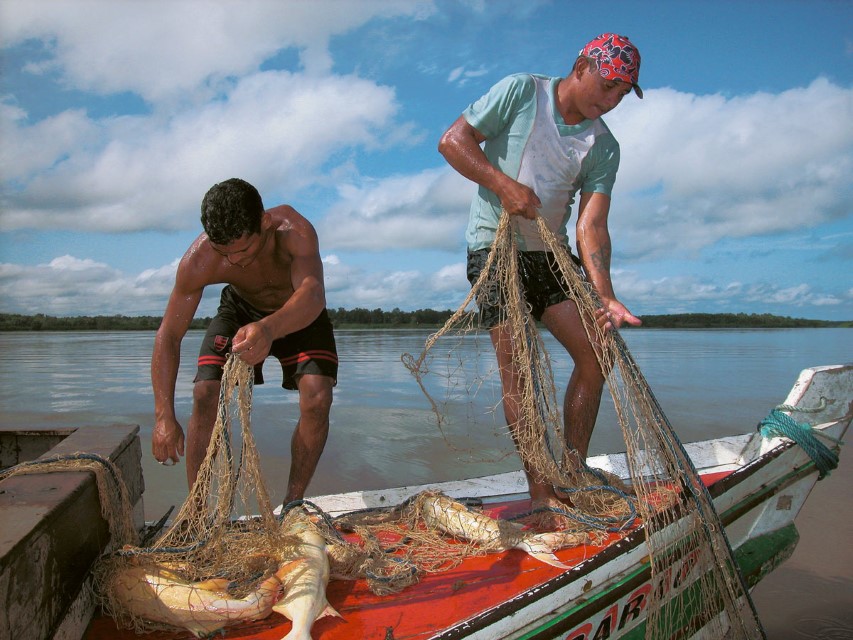
Canal Principal 1
Fishing dourada (Brachyplatystoma rousseauxii) in the Rio Amazonas channel when schools are migrating upstream from estuary. Near Gurupá, Pará, Brazil. Photographer: Luiz Claudio Marigo
-
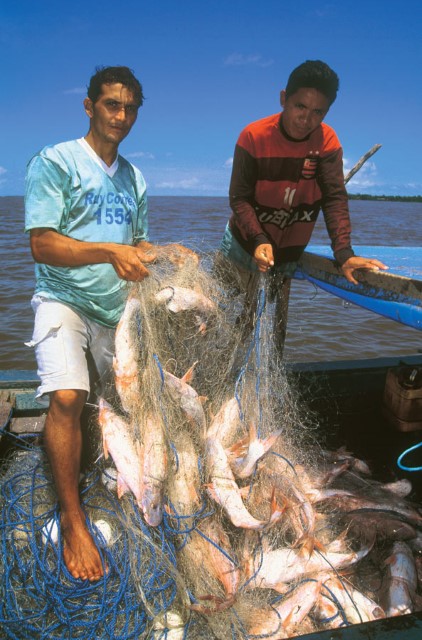
Canal Principal 2
Capture of migratory piramutaba (Brachyplatystoma vaillantii) with gill net in Rio Amazonas channel near Santarém. Department – Country: Pará – Brazil Main Basin – Sub Basin: Amazon Main Stem – Eastern Amazon Main Stem Photographer: Luiz Claudio Marigo
-

Canal Principal 3
Fishing for migratory catfish with drifting gill net in the Rio Amazonas channel near Santarém. Department – Country: Pará – Brazil Main Basin – Sub Basin: Amazon Main Stem – Eastern Amazon Main Stem Photographer: Luiz Claudio Marigo
-

Canal Principal 4
Fishermen encircling school of migratory fish leaving the clear waters of the Rio Machado (Ji-Paraná) to enter the muddy waters of the Rio Madeira. Calama, Rondônia, Brazil. Department – Country: Pará – Brazil Main Basin – Sub Basin: Amazon Main Stem – Eastern Amazon Main Stem Photographer: Michael Goulding
-

Canal Principal 5
Large dourada (Brachyplatystoma rousseauxii) from the Rio Amazonas near Iquitos, Peru. Photographer: Michael Goulding
-
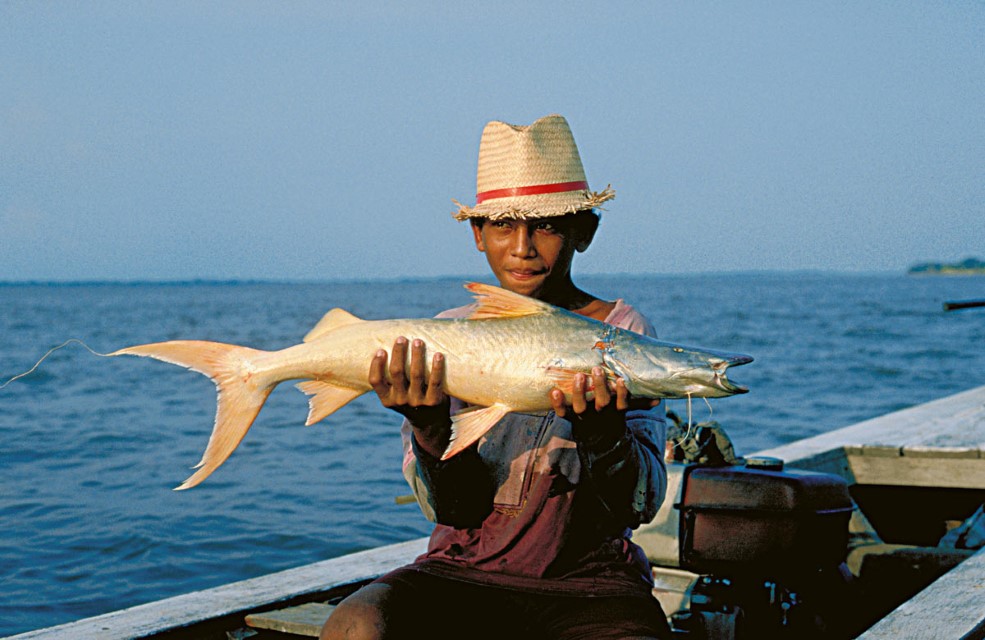
Canal Principal 6
Dourada (Brachyplatystoma rousseauxii) captured in rio Amazonas near Santarém. Photographer: Michael Goulding
-
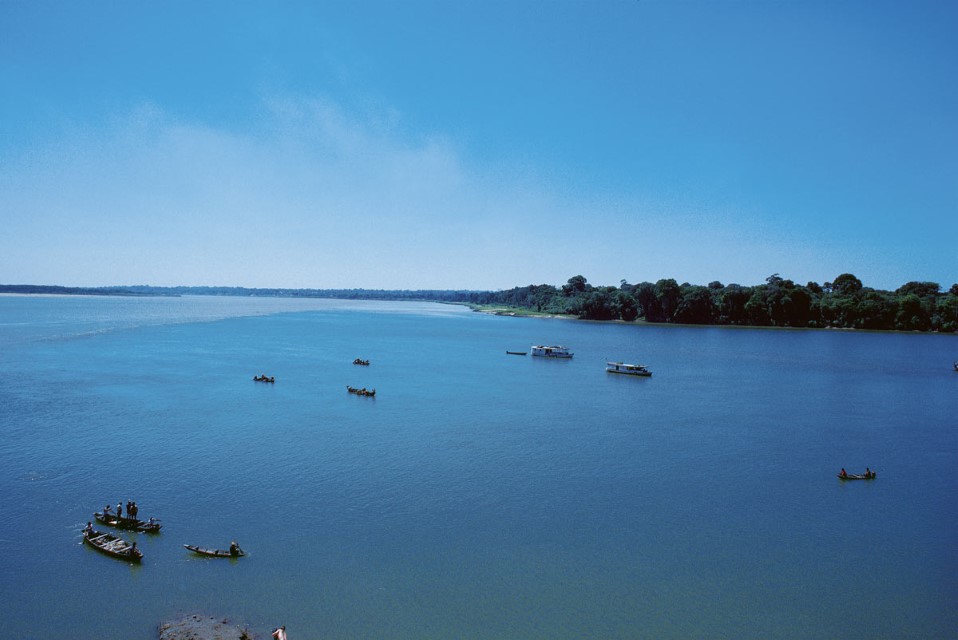
Canal Principal 7
Confluence of Rio Machado (Ji-Paraná) and Rio Madeira. Fishing boats anchor in mouth of Rio Machado to wait for fish migrating downstream to make upstream migrations in Rio Madeira during the low water period. Department – Country: Pará – Brazil Main Basin – Sub Basin: Xingu – Xingu Main Stem Photographer: Michael Goulding
-
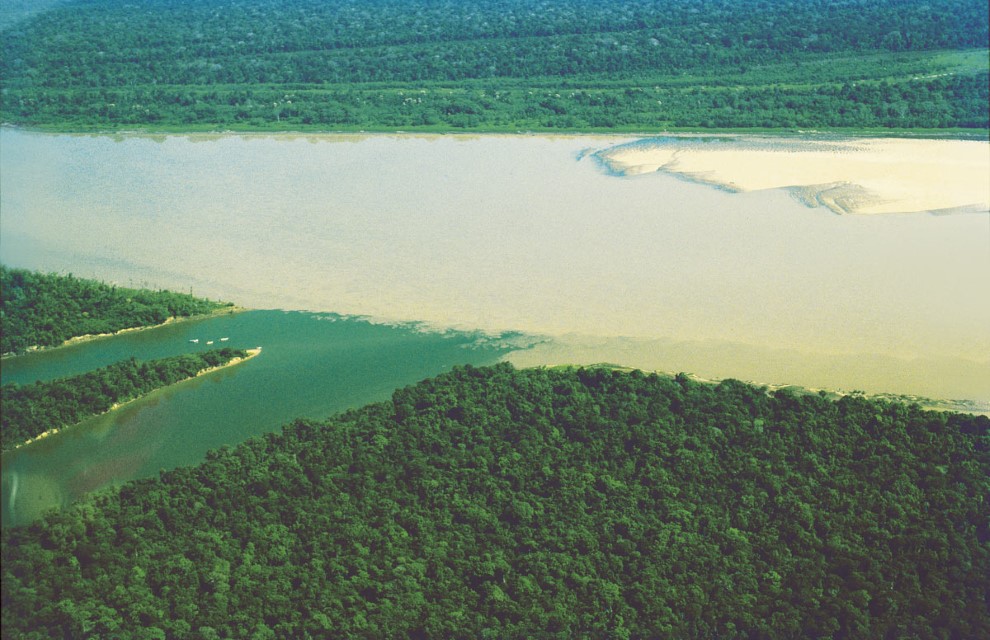
Canal Principal 8
Confluence of the clearwater Rio Jiparaná (Machado) and Rio Madeira. Department – Country: Rondônia – Brazil Main Basin – Sub Basin: Madeira – Jiparaná or Machado Photographer: Michael Goulding
CONTEXT
The Andes
Cataratas
Floodplain or Várzea
River Mouth Bays
River Channel
Estuary & Amazon Coast
Marajó and Inner Delta
